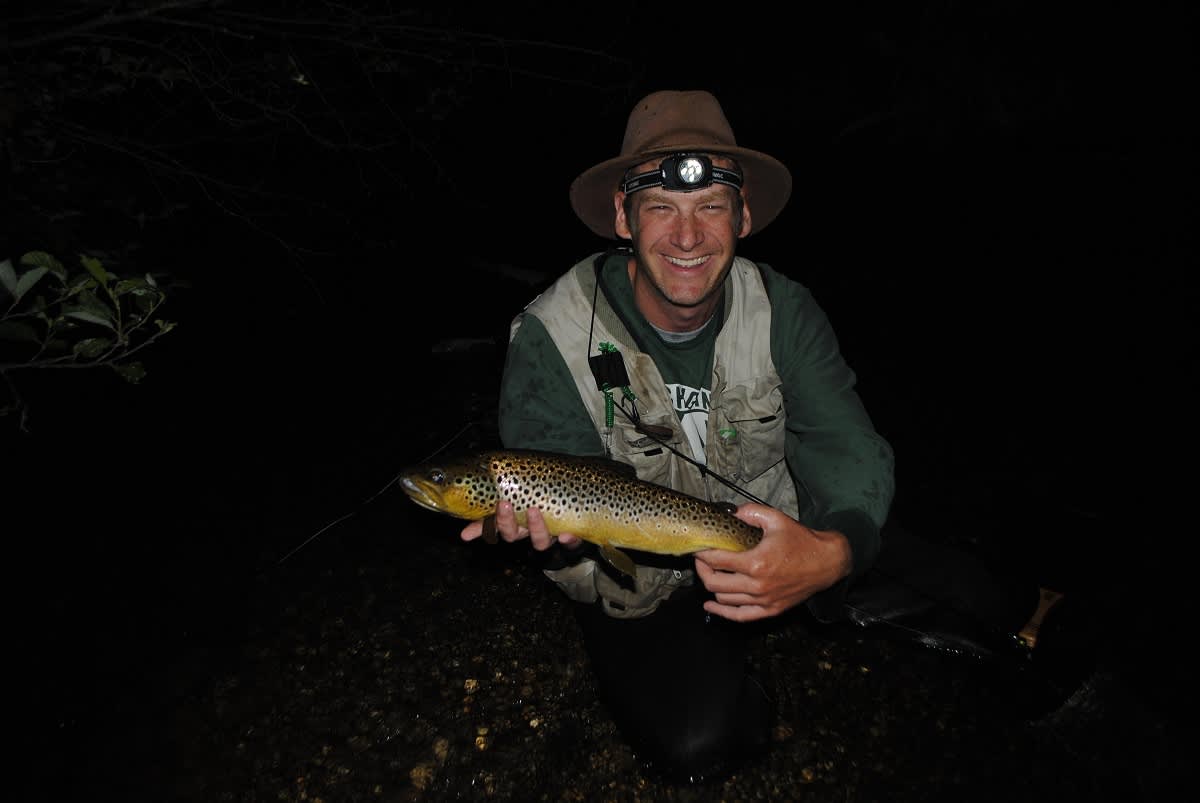Fly Fishing the Hex Hatch on the Au Sable River
Bob Gwizdz 07.11.14

The fish took my fly with a loud splash in the darkness, not much more than about four or five rod lengths from Chris Lessway’s drift boat. When I shot the rod tip skyward, we were one.
It was a good fish, putting a nice bend in the seven-weight fly rod, I worked quickly to pick up the slack line and get the fish on the reel, but as soon as I did—before I even put any pressure on it—it came unbuttoned.
Rats. So that’s how it’s going to be, eh?
I have a love/hate relationship with the hex hatch, which seems like just about every other Michigan fly fisherman’s favorite time of year. It is certainly when the big fish come out (and when the big bugs come out), but I have had less success converting that hatch into big fish than just about anyone I’ve ever talked to.
I’d done everything right, but nothing seems to connect.
“Sometimes they just pop off,” Lessway said.

Sometimes I think I’m just hexed. When it comes to the hex (as in Hexagenia limbata, the giant mayfly) hatch, it’s always something.
This was my second night on the Au Sable River fishing the hex hatch this year. A couple of nights earlier, I’d met up with Tom Goniea, a fisheries biologist for the Department of Natural Resources, who told me he’d had good bugs the previous night. There was every reason to believe it was going to happen—it had been a hot, muggy day, the kind that screams “Hatch.” And as we sat on the riverside, waiting for darkness, the isonychias were in the air.
At dark, we waded out to where a small handful of fish were feeding and waited. Where were the hexes? Nowhere.
Goniea had a fish feed near him and he cast to it a handful of times, switched flies, cast to it again a few times, switched flies again, and got the fish to take. He wrestled it into the shallows and got it in the net. A beauty: a little more than 19 inches.
Goniea was looking for an 18-inch fish (the minimum length limit on this stretch of river) to take home for dinner, but, after posing for a photo, let the brown go.
“I’m not going to kill what could be somebody’s fish of the year,” he said.
He had a point. It was a little better than he best brown I’d taken this year (on a Rapala) and bigger than any I’d caught on a fly this season. I’d have been tickled with it.
Lessway said we’d have plenty more chances and, as we drifted downstream, he anchored the boat where we heard some fish feeding. I was casting to a fish that was feeding near the bank just downstream from our position, while Lessway presented to a fish that was further out in the river but just upstream from our position. His fish took. Lessway hauled it in. It was a dandy—19 or 20 inches, by my guesstimate (we didn’t have a tape measure). He posed for a quick photo and let it go. My fish, which continued to feed, never took my fly.

So we drifted on downstream. The front platform of the drift boat was littered with bugs. I switched on my headlamp and looked at the river; there were tons of spent hexes on the water.
This was the other extreme—too many bugs. When you get a blanket hatch, the odds that a fish will select your fly from the bugs floating overhead become long. I fished to a nice fish that set up along an eddy, but was unable to get a good drift over it. Foiled again.
We drifted downstream under a starry sky than not even van Gogh could have imagined. Fireflies lit up. Bullfrogs and night hawks called. Here and there, a beaver smacked the water. It reminded me why I love the hex hatch—the river was alive, under the cover of darkness.
The fish stopped feeding. We drifted for a mile or so, when we heard a couple of fish feed. Lessway anchored the boat. We waited to see if they would feed with any rhythm. They didn’t; a fish would feed, then nothing, nothing, nothing, then feed again, minutes later. It was as though it was full, but every once in while it couldn’t help itself—sort of the way your hand goes for the M&M’s in a candy dish. It seemed to be acting more out of reflex than hunger.
I tried one a few times and, just about when I was about to give up, it took my fly. Lessway immediately began coaching me. “That’s a big fish, don’t horse it,” he said. I didn’t.
Gradually, I brought it upside the boat and Lessway got it in the net. It was a beaut: 22 to 23 inches, fat, healthy. Lessway held it for a photo, took a photo of me with it, put it in the net, revived it, and released it.
It was the kind of fish that keep you coming back, year after year.
For more information on Michigan fishing go to michigan.org. Click here to purchase a Michigan fishing license online.
This article was produced in partnership with Pure Michigan.

